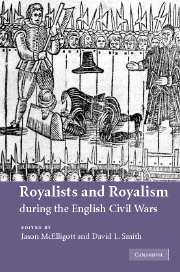Book contents
- Frontmatter
- Contents
- Notes on contributors
- Preface
- Abbreviations
- 1 Introduction: rethinking royalists and royalism
- 2 A lesson in loyalty: Charles I and the Short Parliament
- 3 The Court and the emergence of a royalist party
- 4 Varieties of royalism
- 5 Royalist reputations: the Cavalier ideal and the reality
- 6 Counsel and cabal in the king's party, 1642–1646
- 7 ‘I doe desire to be rightly vnderstood’: rhetorical strategies in the letters of Charles I
- 8 Royalists and the New Model Army in 1647: circumstance, principle and compromise
- 9 The royalist origins of the separation of powers
- 10 ‘A No-King, or a New’. Royalists and the succession, 1648–1649
- 11 The royalism of Andrew Marvell
- Subject Index
- Author Index
8 - Royalists and the New Model Army in 1647: circumstance, principle and compromise
Published online by Cambridge University Press: 19 July 2009
- Frontmatter
- Contents
- Notes on contributors
- Preface
- Abbreviations
- 1 Introduction: rethinking royalists and royalism
- 2 A lesson in loyalty: Charles I and the Short Parliament
- 3 The Court and the emergence of a royalist party
- 4 Varieties of royalism
- 5 Royalist reputations: the Cavalier ideal and the reality
- 6 Counsel and cabal in the king's party, 1642–1646
- 7 ‘I doe desire to be rightly vnderstood’: rhetorical strategies in the letters of Charles I
- 8 Royalists and the New Model Army in 1647: circumstance, principle and compromise
- 9 The royalist origins of the separation of powers
- 10 ‘A No-King, or a New’. Royalists and the succession, 1648–1649
- 11 The royalism of Andrew Marvell
- Subject Index
- Author Index
Summary
In the summer of 1647 the parliamentarian New Model Army decisively asserted its right to act according to its own political conscience, defying parliament's attempt to disband it. Some royalists were prepared to go a long way towards rapprochement with the army, defending its actions as a return to true obedience – to the king – and urging army and king to make a deal which would restore Charles I but protect the interests of the soldiers. Among the army and their political allies the Independents there were men who were also interested in just such a settlement, and some of them, as well as some of the royalists, began to advocate such a solution publicly almost as soon as the army gained custody of the king.
This potential rapprochement invites two extremes of interpretation. One is to see these moves as simple switches of allegiance: these particular army men had simply become royalists, or at least flirted with something that was recognizably ‘royalism’. Those historians who deploy the terms ‘royalism’ of New Model Army men, or ‘crypto-royalism’ of some Presbyterian and City ringleaders, may be boxing themselves into an overly rigid framework in which ‘parliamentarian’ and ‘royalist’ identities are fossilized and all the historical actors can do is change one for the other. Given how much we know about the complexities of politics within each side, this seems a peculiarly reductive model of the relationship between the sides.
- Type
- Chapter
- Information
- Royalists and Royalism during the English Civil Wars , pp. 155 - 174Publisher: Cambridge University PressPrint publication year: 2007

